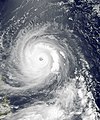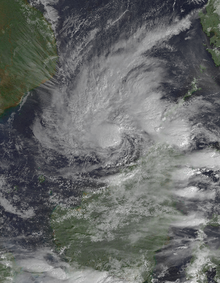Portal:Tropical cyclones
The Tropical Cyclones Portal

A tropical cyclone is a storm system characterized by a large low-pressure center, a closed low-level circulation and a spiral arrangement of numerous thunderstorms that produce strong winds and heavy rainfall. Tropical cyclones feed on the heat released when moist air rises, resulting in condensation of water vapor contained in the moist air. They are fueled by a different heat mechanism than other cyclonic windstorms such as Nor'easters, European windstorms and polar lows, leading to their classification as "warm core" storm systems. Most tropical cyclones originate in the doldrums, approximately ten degrees from the Equator.
The term "tropical" refers to both the geographic origin of these systems, which form almost exclusively in tropical regions of the globe, as well as to their formation in maritime tropical air masses. The term "cyclone" refers to such storms' cyclonic nature, with anticlockwise rotation in the Northern Hemisphere and clockwise rotation in the Southern Hemisphere. Depending on its location and intensity, a tropical cyclone may be referred to by names such as "hurricane", "typhoon", "tropical storm", "cyclonic storm", "tropical depression" or simply "cyclone".
Types of cyclone: 1. A "Typhoon" is a tropical cyclone located in the North-west Pacific Ocean which has the most cyclonic activity and storms occur year-round. 2. A "Hurricane" is also a tropical cyclone located at the North Atlantic Ocean or North-east Pacific Ocean which have an average storm activity and storms typically form between May 15 and November 30. 3. A "Cyclone" is a tropical cyclone that occurs in the South Pacific and Indian Oceans.
Selected named cyclone -
Tropical Depression Greg was a Pacific tropical cyclone that formed at an unusually low latitude in the South China Sea, and became the worst tropical cyclone to affect Malaysia since reliable records began. The last storm of the 1996 Pacific typhoon season, Greg formed on December 24 on the same two monsoon troughs that also spawned Tropical Storm Fern in the basin and cyclones Ophelia, Phil and Fergus in the Southern Hemisphere. The storm headed an east-southeastward track and despite an unfavorable environment for intensification, Greg strengthened to a tropical storm on Christmas Day. It then reached its peak intensity shortly, with maximum sustained winds of 85 km/h (55 mph) and a minimum barometric pressure of 1002 hPa before making landfall along the northern portion of the Malaysian state of Sabah between 1700 and 1800 UTC (3:00 - 4:00 am MYT) on December 26. After crossing the state, it weakened to a tropical depression before passing through Tawi-Tawi in the Philippines on the next day. Wind shear further degraded the system until it dissipated on December 27 on the Celebes Sea, south of Mindanao.
Greg was the only two systems to made landfall in Malaysia, before Vamei in 2001 did so, nearly five years later. The storm brought extensive and catastrophic damages across Sabah, causing over $280 million in damage (1996 USD) and 238 deaths, which mainly are foreigners and tourists. Another 102 individuals were also rendered missing. Flash floods and widespread mudslides were also recorded throughout the state, destroying houses and overflowing rivers, respectively. (Full article...)Selected article -
The effects of Hurricane Mitch in Honduras were destructive and deadly, resulting in the most significant flooding in Honduras in the 20th century. Hurricane Mitch, the strongest storm of the 1998 Atlantic hurricane season, formed on October 22, and after becoming a Category 5 hurricane, it weakened and struck Honduras on October 29. While near peak intensity, Mitch struck the offshore Guanaja island, where it nearly destroyed the mangrove forest. On the mainland, the hurricane dropped torrential rainfall, and many gauges were washed away in mountainous areas where unofficial rainfall totals were as high as 1900 mm (75 in). The highest official total was 928 mm (36.5 in) at Choluteca in southern Honduras, which was more than half of the annual precipitation average there. The rains caused widespread flooding and landslides, although impact from winds was not as severe.
Then-President of Honduras, Carlos Roberto Flores, estimated that Mitch set back 50 years of economic development. The storm wrecked about 35,000 houses and damaged another 50,000, leaving up to 1.5 million people homeless, or about 20% of the country's population. Mitch directly caused $2.005 billion in damage, with an additional $1.8 billion in indirect costs. Most of the damage was ruined crops, and cash crop exports were cut by 9.4% in 1999, largely due to the storm. Over 70% of the transportation infrastructure was damaged, mostly damaged highways and bridges. Widespread areas experienced power outages, and about 70% of the country lost water after the storm. In the capital, Tegucigalpa, a large landslide affected three neighborhoods and formed a temporary dam. Floods in the city damaged buildings that were over 350 years old. Throughout the country, there were at least 7,000 fatalities, some reported in each department. (Full article...)Selected image -

Selected season -

The 2016 Atlantic hurricane season was the first above-average hurricane season since 2012, producing 15 named storms, 7 hurricanes and 4 major hurricanes. The season officially started on June 1 and ended on November 30, though the first storm, Hurricane Alex which formed in the Northeastern Atlantic, developed on January 12, being the first hurricane to develop in January since 1938. The final storm, Otto, crossed into the Eastern Pacific on November 25, a few days before the official end. Following Alex, Tropical Storm Bonnie brought flooding to South Carolina and portions of North Carolina. Tropical Storm Colin in early June brought minor flooding and wind damage to parts of the Southeastern United States, especially Florida. Hurricane Earl left 94 fatalities in the Dominican Republic and Mexico, 81 of which occurred in the latter. In early September, Hurricane Hermine, the first hurricane to make landfall in Florida since Hurricane Wilma in 2005, brought extensive coastal flooding damage especially to the Forgotten and Nature coasts of Florida. Hermine was responsible for five fatalities and about $550 million (2016 USD) in damage.
The strongest, costliest, and deadliest storm of the season was Hurricane Matthew, the southernmost Category 5 Atlantic hurricane on record and the first to reach that intensity since Felix in 2007, ending the longest streak of seasons without a hurricane of such intensity in the Satellite Era. With at least 603 deaths attributed to it, Matthew was the deadliest Atlantic hurricane since Stan of 2005. Furthermore, damage from Matthew is estimated to be at least $16.5 billion, making it the ninth costliest Atlantic hurricane on record at the time. Hurricane Nicole became the first major hurricane to directly impact Bermuda since Hurricane Fabian in 2003, leaving widespread but relatively moderate damage on the island. The final tropical cyclone of the season – Hurricane Otto – brought severe flooding to Central America in November, particularly in Costa Rica and Nicaragua. Otto left 23 deaths and about $190 million in damage. On November 25, the storm emerged into the Eastern Pacific basin, the first such occurrence since Hurricane Cesar–Douglas in 1996. Most of the season's tropical cyclones impacted land, and nine of those storms caused loss of life. Collectively, the storms left at least 736 fatalities and $17.49 billion in damage, making the season the costliest since 2012. (Full article...)Related portals
Currently active tropical cyclones

Italicized basins are unofficial.
- North Atlantic (2024)
- No active systems
- East and Central Pacific (2024)
- No active systems
- West Pacific (2024)
- No active systems
- North Indian Ocean (2024)
- No active systems
- Mediterranean (2023–24)
- No active systems
- South-West Indian Ocean (2023–24)
- No active systems
- Australian region (2023–24)
- No active systems
- South Pacific (2023–24)
- No active systems
- South Atlantic (2023–24)
- No active systems
Last updated: 21:54, 8 May 2024 (UTC)
Tropical cyclone anniversaries

- May 12, 1991 - Typhoon Walt (pictured) reached its peak intensity to the east of the Philippines with 260 km/h (160 mph) winds. Cyclone Lisa developed in the Southern Hemisphere concurrently with Walt.

- May 13, 2001 - Tropical Storm Cimaron (pictured) reached its peak intensity with 110 km/h (70 mph) winds shortly before it struck the Okinawa Islands, bringing heavy rain.

May 14
- 1997 - Cyclone Rhonda reached its peak intensity in the open Indian Ocean with winds of 185 km/h (115 mph).
- 2007 - Cyclone Akash (pictured) damages a total of US$982 million over in Bangladesh and Burma, also killing a total of 14.
- 2020 - Typhoon Vongfong makes landfall over Visayas, Philippines as a Category 3 typhoon.
Did you know…




- …that the Joint Typhoon Warning Center considers that Typhoon Vera (pictured) of 1986 is actually two distinct systems, formed from two separated low-level circulations?
- …that Hurricane Agatha (pictured) was the strongest Pacific hurricane to make landfall in Mexico in May since records began in 1949?
- …that Cyclone Raquel (track pictured) travelled between the Australian and South Pacific basins between the 2014–15 and 2015–16 seasons, spanning both seasons in both basins?
- …that Cyclone Amphan (pictured) in 2020 was the first storm to be classified as a Super Cyclonic Storm in the Bay of Bengal since 1999?
General images -

The list of Florida storms from 1950 to 1974 encompasses 85 Atlantic tropical or subtropical cyclones that affected the U.S. state of Florida. Collectively, tropical cyclones in Florida during the time period resulted in about $7.04 billion (2017 USD) in damage, primarily from Hurricanes Donna and Dora. Additionally, tropical cyclones in Florida were directly responsible for 93 fatalities during the period, as well as responsible for 23 indirect deaths. Several tropical cyclones produced over 20 inches (500 mm) of rainfall in the state, including Hurricane Easy which is the highest total during the time period. The 1969 season was the year with the most tropical cyclones affecting the state, with a total of 8 systems. The 1954 and 1967 seasons were the only years during the time period in which a storm did not affect the state.
The strongest hurricane to hit the state during the time period was Donna in 1960, which was the 8th strongest hurricane on record to strike the United States. Additionally, Hurricanes Easy, King, Isbell, and Betsy hit the state as major hurricanes.
(Full article...)Topics
Subcategories
Related WikiProjects
WikiProject Tropical cyclones is the central point of coordination for Wikipedia's coverage of tropical cyclones. Feel free to help!
WikiProject Weather is the main center point of coordination for Wikipedia's coverage of meteorology in general, and the parent project of WikiProject Tropical cyclones. Three other branches of WikiProject Weather in particular share significant overlaps with WikiProject Tropical cyclones:
- The Non-tropical storms task force coordinates most of Wikipedia's coverage on extratropical cyclones, which tropical cyclones often transition into near the end of their lifespan.
- The Floods task force takes on the scope of flooding events all over the world, with rainfall from tropical cyclones a significant factor in many of them.
- WikiProject Severe weather documents the effects of extreme weather such as tornadoes, which landfalling tropical cyclones can produce.
Things you can do
 |
Here are some tasks awaiting attention:
|
Wikimedia
The following Wikimedia Foundation sister projects provide more on this subject:
-
Commons
Free media repository -
Wikibooks
Free textbooks and manuals -
Wikidata
Free knowledge base -
Wikinews
Free-content news -
Wikiquote
Collection of quotations -
Wikisource
Free-content library -
Wikiversity
Free learning tools -
Wikivoyage
Free travel guide -
Wiktionary
Dictionary and thesaurus
























































